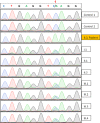A novel mutation deep within intron 7 of the GBA gene causes Gaucher disease
- PMID: 31943857
- PMCID: PMC7057115
- DOI: 10.1002/mgg3.1090
A novel mutation deep within intron 7 of the GBA gene causes Gaucher disease
Abstract
Background: Mutations in the GBA gene that encodes the lysosomal enzyme acid β-glucocerebrosidase cause Gaucher disease (GD), the most common lysosomal storage disorder. Most of the mutations are missense/nonsense, however, a few splicing mutations within or close to conserved consensus donor or acceptor splice sites have also been described. The aim of the study was to identify the mutation(s) in a Cypriot patient with type I GD.
Methods: The genomic DNA of the proband was screened for nine common mutations using Polymerase chain reaction-restriction fragment length polymorphism (PCR-RFLP) analysis. All exons and exon-intron boundaries, and the 5'UTR and 3'UTR regions of the GBA gene, were investigated by Sanger sequencing. RNA analysis was performed using standard procedures, and the abnormal transcript was further cloned into pGEM-T-Easy plasmid vector and sequenced. The relevant intronic region was further sequenced by the Sanger method to identify the genetic variant.
Results: A novel point mutation, g.12599C > A (c.999 + 242C > A), was detected deep in intron 7 of the GBA gene. This type of mutation has been previously described for other diseases but this is the first time, as far as we know, that it is described for GD. This mutation creates a new donor splice site leading to aberrant splicing and resulting in the insertion of the first 239nt of intron 7 as a pseudoexon in the mRNA, creating a premature stop codon.
Conclusion: This study expands the mutation spectrum of GD and highlights the importance of RNA sequencing for the molecular diagnosis of patients bearing mutations in nonexonic regions.
Keywords: GBA; Cypriot; Gaucher disease; deep intronic mutation; glucocerebrosidase.
© 2019 The Authors. Molecular Genetics & Genomic Medicine published by Wiley Periodicals, Inc.
Conflict of interest statement
The authors declare no conflicts of interest.
Figures



References
-
- Anczukow, O. , Buisson, M. , Leone, M. , Coutanson, C. , Lasset, C. , Calender, A. , … Mazoyer, S. (2012). BRCA2 deep intronic mutation causing activation of a cryptic exon: Opening toward a new preventive therapeutic strategy. Cancer Research, 18(18), 4903–4909. 10.1158/1078-0432.CCR-12-1100 - DOI - PubMed
Publication types
MeSH terms
Substances
Associated data
- Actions
- Actions
- Actions
- Actions
LinkOut - more resources
Full Text Sources
Medical

